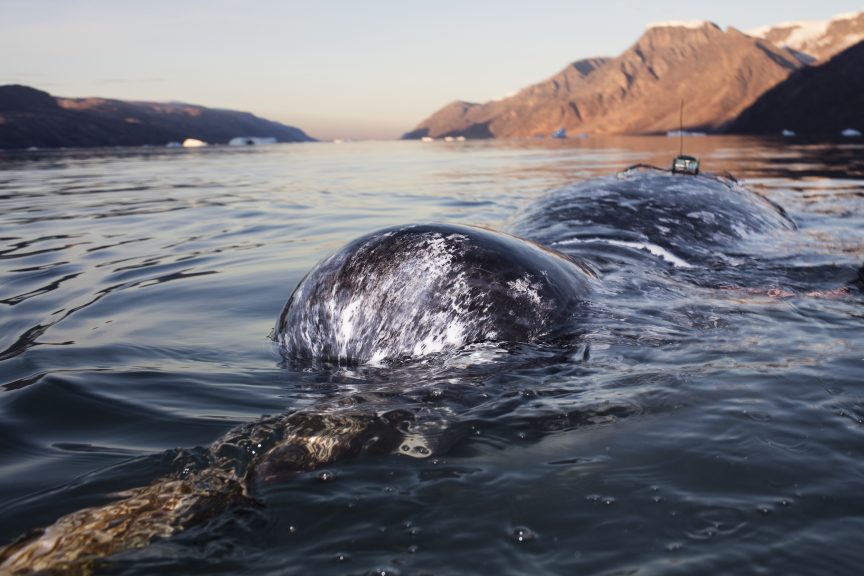Noise pollution – Better knowledge of the noise in Arctic seas Published 08.02.2019

The sea is not a silent world. There is a lot of noise below the surface. A large part of this noise is made by us humans, e.g. when we sail and when we look for oil. A new research study shows that models can predict the amount of noise pollution we produce, which may turn out to be a great tool for regulating ocean noise pollution.
By Peter Bondo – pbc@bios.au.dk
When we look for oil in the sea bed, we do not search at random. Ships equipped with airguns sail around and fire loud sounds toward the sea floor. The reflexion of the sound can reveal potential oil-containing layers in the sea floor.
An airgun makes a loud blast, a sound that is among the loudest human-made sounds, and the noise can be registered in the open sea from a distance of more than 3000 kilometres. An airgun fires one shot approx. every tenth second, so a sailing ship, making a seismic survey, is an immense source of noise.
A sea of noise
In Baffin Bay between the north-western part of Greenland and Canada, researchers from Aarhus University and the Greenland Climate Research Centre have had the opportunity of measuring the ocean noise pollution through 31 underwater microphones throughout two and a half months, while four seismic survey vessels were working in the area.
The researchers were able to establish that the noise level rose and accumulated each time a new ship began its seismic measurements. During the study the researches registered underwater noise levels of up to 70 dB higher than the background noise level. This equals the difference between the sound level in a quiet living room and the sound level at a rock concert.
Also, between the firing of the airguns, the noise level never dropped to a undisturbed level, and the noise conditions are therefore significantly distorted for marine animals during seismic surveys.
The results of the survey were recently published in the renowned scientific magazine Marine Pollution Bulletin.
Models describe actual measurements
Before seismic surveys can be carried out in Greenland, possible effects are carefully considered with the current knowledge of the area, and certain zones have been selected to be closed in certain periods to protect vulnerable marine mammal species.
Companies carrying out seismic surveys in Greenland must produce a model that both illustrates how much noise the seismic ships make, individually and combined, as well as show how and how far the noise will spread. This gives the authorities a possibility of assessing to which extent the marine mammals will be affected by the total activities.
Through the studies in Baffin Bay, the scientists had the opportunity to compare the modelled underwater noise level with the registered noise level, measured through the laid-out microphones. The survey showed that the utilised models give a realistic image of the actual underwater noise levels produced by the airguns.
”This means that we have a good tool for advising the authorities that grant permissions for oil explorations in the Arctic areas. When we know the quantity of marine mammals in the difference areas of Greenland, we can advise on at what distance the seismic surveys have to stay from those areas,” says scientist Line A. Kyhn, Institute for Bioscience, Aarhus University that has been leading the research.
Food search and communication disturbed
A diverse and abundant marine animal life is found in the Arctic seas. Many of these animals are completely dependent on the ability to use sound in order to communicate and seek food. This applies to whales, fish and crustacean, and so on. The scientists therefore are concerned about how the massive sources of noise will affect the populations of these animals, which in several cases also are of important commercial interest to Greenland.
”There are few dedicated studies of the effect of noise on whales and fish, but from studies of Danish porpoise we know that porpoise leave areas that are affected by high levels of noise, and that they eat less food in areas, where seismic studies are carried out. And from Norwegian studies we know that also fish react to the sound from airguns,” says Line A. Kyhn.
In other surveys scientists have observed how narwhals in the Arctic area flee from the noise of a icebreaker, even at distances of up to 70 kilometres, just as belugas have been seen to flee from sources of noise. At the moment, the Greenland Institute of Natural Resources is researching how narwhals’ behaviour changes, when they are exposed to the noise of a seismic airgun.
”When we know how the animals react to different noise levels, we can use this knowledge to assess the effects that future industrial projects using seismic surveys will have on marine mammals. We are currently researching the effects of seismic noise on narwhals, however, there are many Arctic species of fish, seals and whales, where we still do not know anything about their vulnerability to the noise of airguns,” tells Head of Department Malene Simon from the Climate Research Centre that also has been part of the study.
More information:
Scientist Line A. Kyhn, Institute for Bioscience, Aarhus University. Email: lky@bios.au.dk; phone: +45 3018 3148.
Head of department, senior researcher, Malene Simon, Greenland Climate Research Centre, Nuuk. Email: masi@natur.gl;phone: +299 361250
Link to the scientific article: authors.elsevier.com/a/1YCM5,ashq8ew

